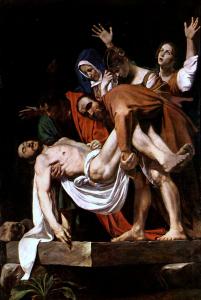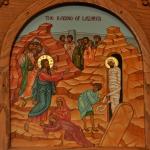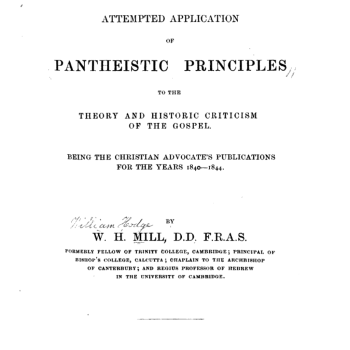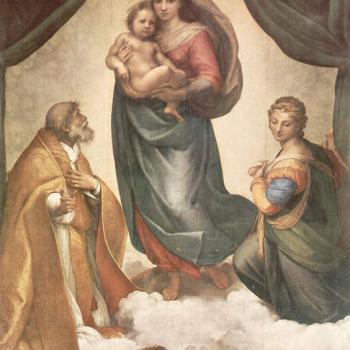Matthew 13:55 (RSV) Is not this the carpenter’s son? Is not his mother called Mary? And are not his brothers James and Joseph and Simon and Judas?
Matthew 27:55-56, 61 There were also many women there [at the crucifixion], looking on from afar, who had followed Jesus from Galilee, ministering to him; [56] among whom were Mary Mag’dalene, and Mary the mother of James and Joseph, . . . [61] Mary Mag’dalene and the other Mary were there, sitting opposite the sepulchre.
Matthew 28:1 Now after the sabbath, toward the dawn of the first day of the week, Mary Mag’dalene and the other Mary went to see the sepulchre.
Mark 6:3 “Is not this the carpenter, the son of Mary and brother of James and Joses and Judas and Simon, . . .?” . . .
Mark 15:40, 47 There were also women looking on from afar, among whom were Mary Mag’dalene, and Mary the mother of James the younger and of Joses, and Salo’me, . . . [47] Mary Mag’dalene and Mary the mother of Joses saw where he was laid.
Mark 16:1 And when the sabbath was past, Mary Mag’dalene, and Mary the mother of James, and Salo’me, bought spices, so that they might go and anoint him.
John 19:25 . . . standing by the cross of Jesus were his mother, and his mother’s sister, Mary the wife of Clopas, and Mary Mag’dalene.
By comparing Matthew 27:56, Mark 15:40, and John 19:25, we find that James and Joseph — mentioned in Matthew 13:55 with Simon and Jude as Jesus’ “brothers” — are also called sons of Mary, wife of Clopas. This other Mary (Matthew 27:61, 28:1) is called Our Lady’s adelphe in John 19:25 (it isn’t likely that there were two women named “Mary” in one family — thus even this usage apparently means “cousin” or more distant relative, or sister-in-law).
Matthew 13:55-56 and Mark 6:3 mention Simon, Jude and “sisters” along with James and Joseph, calling all adelphoi. Since we know for sure that at least James and Joseph are not Jesus’ blood brothers, the most likely interpretation of Matthew 13:55 is that all these “brothers” are cousins, according to the linguistic conventions discussed above. Most Bible scholars equate Jude and Thaddeus. The latter is mentioned in two lists of the disciples that do not contain Jude: Matthew 10:3 and Mark 3:18; for more on this, see Wikipedia, “Jude the Apostle”.
Data from the very early Church makes the matter even more clear, as to the “relative” status of these “brothers” Simon and Jude. Eusebius, in his History of the Church, documents Hegesippus (c. 110 – c. 180) as follows:
After the martyrdom of James and the conquest of Jerusalem which immediately followed, it is said that those of the apostles and disciples of the Lord that were still living came together from all directions with those that were related to the Lord according to the flesh (for the majority of them also were still alive) to take counsel as to who was worthy to succeed James.
They all with one consent pronounced Symeon, the son of Clopas, of whom the Gospel also makes mention; to be worthy of the episcopal throne of that parish. He was a cousin, as they say, of the Saviour. For Hegesippus records that Clopas was a brother of Joseph. (Book III, section 11, parts 1-2; translated by Arthur Cushman McGiffert. From Nicene and Post-Nicene Fathers, Second Series, Vol. 1. Edited by Philip Schaff and Henry Wace. [1890], pp. 123-124 in the version translated by G. A. Williamson, Baltimore: Penguin Books, 1965; cf. Book III, section 32, part 4: “Mary, the wife of Clopas, who was the father of Symeon” and Book III, section 32, part 1: “Symeon, the son of Clopas”)
The same author [Hegesippus, cited in part 1] also describes the beginnings of the heresies which arose in his time, in the following words:
And after James the Just had suffered martyrdom, as the Lord had also on the same account, Symeon, the son of the Lord’s uncle, Clopas, was appointed the next bishop. All proposed him as second bishop because he was a cousin of the Lord. (Book IV, section 22, part 4; Williamson translation, p. 181)
Clopas was the brother of St. Joseph. That would make this “other Mary” (wife of Clopas) the Blessed Virgin Mary’s sister-in-law, and her sons (James and Joseph named), Jesus’ first cousins. It follows by analogy (Mt 13:55; Mk 6:3) that Simon and Jude are also His first cousins. But the direct evidence that Simon is Jesus’ first cousin comes from Hegesippus through Eusebius. The latter (arguably) also alludes to Jude (Judas) being Jesus’ first cousin as well:
The same historian [Hegesippus] says that there were also others, descended from one of the so-called brothers of the Saviour, whose name was Judas, . . . (Book III, section 32, part 5; McGiffert translation; Williamson translates: “one of the ‘brothers’ of the Saviour named Jude . . .”: p. 143)
Thus, Hegesippus arguably confirms that all four “brothers” of Jesus mentioned together in Matthew 13:55 and Mark 6:3, are sons of Mary wife of Clopas, who was an aunt of Jesus. Scripture already directly affirmed that James and Joseph were the sons of Mary, wife of Clopas (Mt 27:56; Mk 15:40). Hegesippus, moreover, informs us that Clopas was a blood brother / sibling of St. Joseph, husband of the Blessed Virgin Mary. Beyond that, since it makes no sense to have two Marys of one mother, this “other Mary” was (consistently and logically interpreting all of this biblical and the earliest patristic data together) the sister-in-law of the Blessed Virgin Mary.
The Catholic Encyclopedia (“The Brethren of the Lord”) makes a further observation about Simon / Symeon:
Some identify him with the Apostle Simon the Cananean (Matthew 10:4; Mark 3:18) or the Zealot (Luke 6:15; Acts 1:13). The grouping together of James, Jude or Thaddeus, and Simon, after the other Apostles, Judas Iscariot excepted, in the lists of the Apostles, (Matthew 10:4-5; Mark 3:18; Luke 6:16; Acts 1:13) lends some probability to this view, as it seems to indicate some sort of connexion between the three.
Scripture provides a bit more indirect evidence about Jude as well. If this is the same Jude who wrote the epistle bearing that name (as many think), he calls himself “a servant of Jesus Christ and brother of James” (Jude 1:1). Now, suppose for a moment that he was Jesus’ blood brother. In that case, he refrained from referring to himself as the Lord’s own sibling (while we are told that such a phraseology occurs several times in the New Testament, referring to a sibling relationship) and chose instead to identify himself as James‘ brother.
This is far too strange and implausible to believe. Moreover, James also refrains from calling himself Jesus’ brother, in his epistle (James 1:1: “servant of God and of the Lord Jesus Christ”): even though St. Paul calls him “the Lord’s brother” (Gal 1:19). Now that we have seen from Holy Scripture that James is Jesus’ first cousin, it follows that if Jude is his sibling (assuming that is the meaning of Jude 1:1), then he is also Jesus’ first cousin.
We have, then, either compelling or (in the case of Jude) very good, plausible biblical arguments showing that James, Joseph, and Jude (aka Thaddeus) are not Jesus’ siblings, and compelling early patristic evidence (about as early and good as it gets), that all four (including Simon) are His first cousins (sons of St. Joseph’s brother Clopas and his wife, the “other” Mary).
Unfortunately, there are additional confusing elements (as if the above weren’t confusing enough!). One is the identity of Alphaeus, who is mentioned in the phrase, “James the son of Alphaeus” in three Gospel passages (Mt 10:3; Mk 3:18; Lk 6:15) and again with the same exact phraseology in Acts 1:13. To top it off, we also have “Levi the son of Alphaeus” in Mark 2:14. Wikipedia (“Alphaeus”) explains the latter as follows:
Usually, in the Western Catholic tradition, there are believed to be two men named Alphaeus. One of them was the father of the apostle James and the other the father of Matthew (Levi). Though both Matthew and James are described as being the “son of Alphaeus,” there is no Biblical account of the two being called brothers, even in the same context where John and James or Peter and Andrew are described as being brothers.
The great Anglican scholar and bishop J. B. Lightfoot (1828-1889), in his classic commentary The Brethren of the Lord (1865) tackled the question of whether Alphaeus = Clopas:
The identity of Alphaeus and Clopas. These two words, it is said, are different renderings of the same Aramaic name yplx or [Aramaic] (Chalphai), the form Clopas being peculiar to St. John, the more completely grecized Alphaeus taking its place in the other Evangelists. The Aramaic guttural Cheth, when the name was reproduced in Greek, might either be omitted as in Alphaeus, or replaced by a k (or c) as in Clopas. Just in the same way Aloysius and Ludovicus are recognized Latin representatives of the Frankish name Clovis (Clodovicus, Hludovicus, Hlouis).
Secondly, in lists of the disciples (RSV), we have the seemingly anomalous “Judas the son of James” (in both Lk 6:16 and Acts 1:13). Neither “brother” (adelphos) nor “son” appear in either passage, so Bible translators are left to interpret the relational “of” as referring to “son” or “brother.” And they differ, as we see regarding the translation of Luke 6:16:
“son of James“: NIV, ESV, RSV, NASB, Amplified, CEV, GNB, NKJV, ASV, Phillips, NAB, NRSV, Moffatt, NEB, REB, Barclay, Williams, Beck, Jerusalem [footnote: “possibly ‘brother . . .'”], Goodspeed
“brother of James“: KJV, Darby, Webster, Douay-Rheims, AKJV, Knox, Confraternity, Wuest, Kleist & Lilly, Bishop’s Bible (1568), Geneva Bible (1587)
Other renderings: “James’s relative Judas” (Weymouth); “Judas of James” (Young’s Literal), “Judas, of James” (Smith’s Literal)
Lightfoot gives his opinion and opts for “brother” on exegetical grounds:
In St. Luke’s catalogues of the Twelve (Luke 6:16; Acts 1:13) the name ‘Judas of James’ (Ἰούδας Ἰακώβου) occurs. Now we find a Judas also among the four brethren of the Lord (Matt 13:55; Mark 6:3); and the writer of the epistle, who was doubtless the Judas last mentioned, styles himself ‘the brother of James’ (Jude 1). This coincidence suggests that the ellipsis in ‘Judas of James’ should be supplied by brother . . ., not by son which would be the more obvious word.
The fact remains that the text contains neither “son” nor “brother” and so this passage cannot be replied on as a reliable indicator for either position. The Catholic Encyclopedia (“The Brethren of the Lord”) notes another relevant consideration:
It is quite in accordance with Greek custom for a man to be distinguished by the addition of his brother’s name instead of his father’s, when the brother was better known. That such was the case with Jude is inferred from the title “the brother of James”, by which he designates himself in his Epistle.
Thirdly, there is dispute about the identity of the various persons named James in the New Testament. The Catholic Encyclopedia (“The Brethren of the Lord”) renders its strong opinion:
James is without doubt the Bishop of Jerusalem (Acts 12:17, 15:13, 21:18; Galatians 1:19; 2:9-12) and the author of the first Catholic Epistle. His identity with James the Less (Mark 15:40) and the Apostle James, the son of Alpheus (Matthew 10:3; Mark 3:18), although contested by many Protestant critics, may also be considered as certain. There is no reasonable doubt that in Galatians 1:19: “But other of the apostles [besides Cephas] I saw none, saving James the brother of the Lord”, St. Paul represents James as a member of the Apostolic college. The purpose for which the statement is made, makes it clear that the “apostles” is to be taken strictly to designate the Twelve, and its truthfulness demands that the clause “saving James” be understood to mean, that in addition to Cephas, St. Paul saw another Apostle, “James the brother of the Lord” (cf. Acts 9:27). Besides, the prominence and authority of James among the Apostles (Acts 15:13; Galatians 2:9; in the latter text he is even named before Cephas) could have belonged only to one of their number. Now there were only two Apostles named James: James the son of Zebedee, and James the son of Alpheus (Matthew 10:3; Mark 3:18; Luke 6:16; Acts 1:13). The former is out of the question, since he was dead at the time of the events to which Acts 15:6 ssq., and Galatians 2:9-12 refer (cf. Acts 12:2). James “the brother of the Lord” is therefore one with James the son of Alpheus, and consequently with James the Less, the identity of these two being generally conceded.
ADDENDUM: Adelphos (“brother”) was used in the NT because it was following Aramaic / Hebrew cultural practice. They would say “brother” for both siblings and cousins and even for nephews (Abraham and Lot). We have to think how they thought then in that culture and with that language, not like we do today.
***
***
Summary: I provide various exegetical and early patristic reasons (from Hegesippus via Eusebius) for Simon & Jude being the sons of Mary, wife of Clopas, & Jesus’ 1st cousins.














